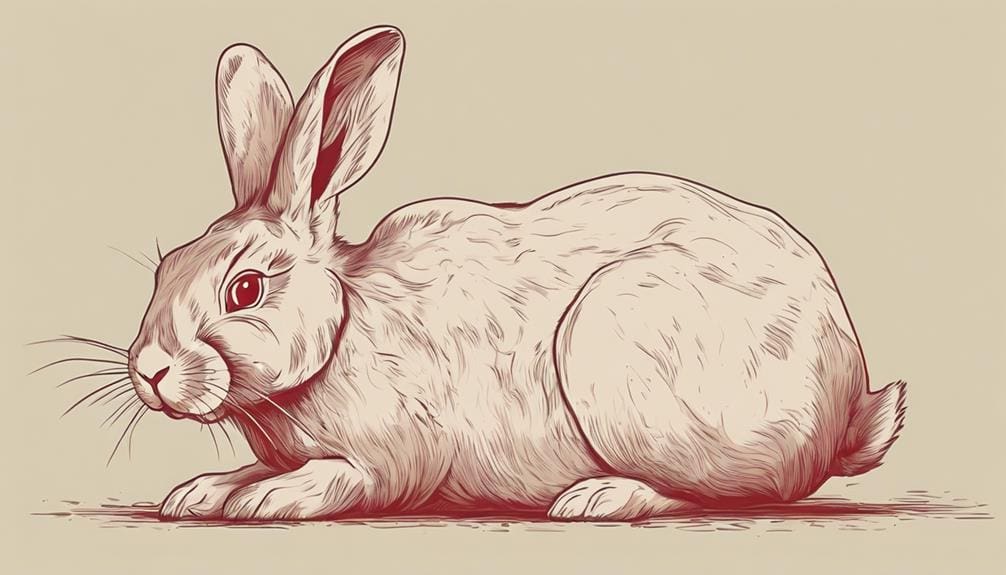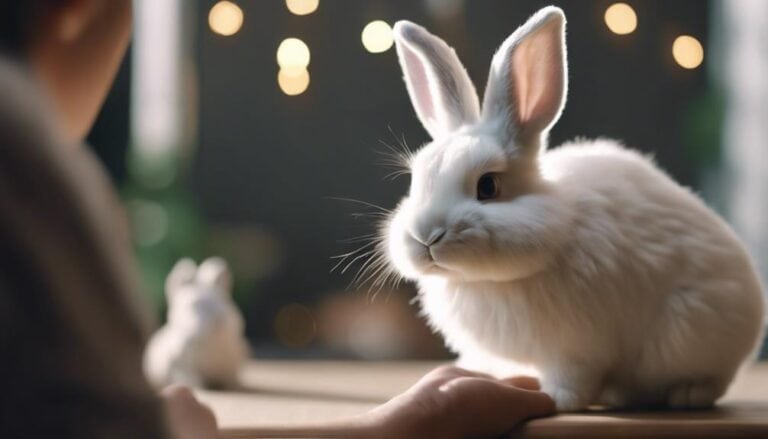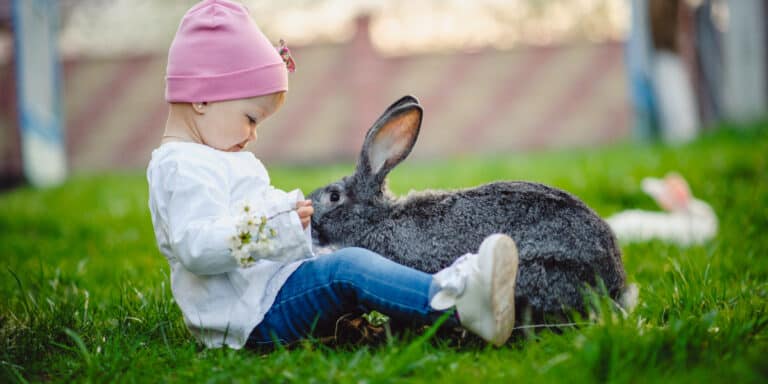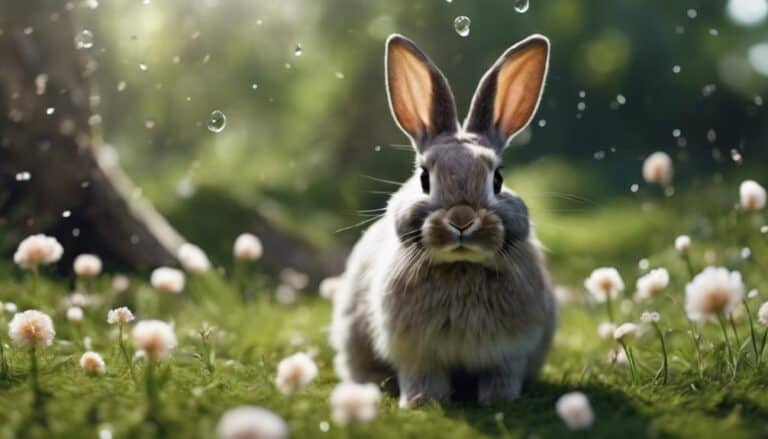You might think that bunnies are just cute, fluffy creatures, but did you know that understanding bunny body language goes beyond their adorable appearance?
The way your bunny communicates through its body can reveal a lot about its well-being and emotions. By deciphering these subtle cues, you can guarantee a harmonious relationship with your furry friend.
But how exactly does decoding bunny body language benefit you as a responsible pet owner? Let's uncover the significance of this essential skill together.
Contents
- 1 Key Takeaways
- 2 Importance of Bunny Body Language
- 3 Communication Through Bunny Behavior
- 4 Understanding Your Bunny's Emotions
- 5 Signs of Happy Bunnies
- 6 Red Flags in Bunny Behavior
- 7 Addressing Unhappiness in Bunnies
- 8 Creating a Bunny-Friendly Environment
- 9 Enhancing Bunny-Human Bond
- 10 Frequently Asked Questions
- 11 How Does Bunny Grooming Play a Role in Understanding Bunny Body Language?
- 12 Conclusion
Key Takeaways
- Enhances bond and communication with your pet rabbit.
- Helps address emotions, needs, and mood effectively.
- Prevents misunderstandings and promotes emotional well-being.
- Vital for interpreting happiness, distress, and well-being cues accurately.
Importance of Bunny Body Language

Recognizing the significance of bunny body language is essential for fostering a strong bond with your pet rabbit and ensuring their emotional well-being. Rabbits communicate primarily through body language, conveying their emotions, needs, and mood without uttering a single word. By understanding your rabbit's body language, you can decipher their feelings and respond appropriately, thereby preventing stress and misunderstandings.
Observing subtle cues like ear positions, tail movements, and body postures provides valuable insights into your rabbit's well-being. For instance, a relaxed rabbit with ears perked up is likely content, while a rabbit with its tail tucked between its legs may be feeling scared or anxious. Recognizing these signs allows you to adjust your interactions accordingly, building trust and strengthening your relationship with your furry companion.
Communication Through Bunny Behavior
To decipher the subtle messages conveyed through bunny behavior, pay close attention to their specific ear positions, tail movements, and body postures. Rabbit body language is a fascinating form of communication that offers valuable insights into your furry friend's emotions, mood, and well-being.
By observing their behaviors such as ear positioning (perked up, laid back, or sideways), tail movements (upright, lowered, or twitching), and body postures (relaxed, tense, or crouched), you can better understand what your bunny is trying to express. For instance, a bunny with ears laid back and a thumping tail might be feeling scared or threatened, while one with ears perked up and a relaxed body posture is likely content and at ease.
Recognizing and interpreting these cues not only enhances your bond with your rabbit but also guarantees their happiness and comfort. By actively engaging with your bunny's body language, you pave the way for a deeper level of communication and connection with your beloved pet.
Understanding Your Bunny's Emotions

Understanding your bunny's emotions is key to fostering a strong bond and ensuring their well-being. By paying attention to your rabbit's body language, you can interpret their feelings and address their needs effectively.
Rabbits communicate through a variety of cues such as ear positions, tail movements, and body postures. When your bunny is happy, they may exhibit relaxed body language, with ears up and a gentle swaying of their tail. On the other hand, signs of anxiety or fear could include flattened ears, a tense body, or thumping their hind legs.
If your rabbit is scared or in distress, they might cower, freeze, or show signs of aggression. Being attuned to these emotional signals allows you to respond appropriately, providing comfort and support when needed. By understanding your bunny's emotions, you can nurture a happy and healthy relationship with your furry companion.
Signs of Happy Bunnies
When your bunny is happy, you might notice relaxed body language, with ears slightly back and partly closed eyes. Joyful bunnies often showcase playful behaviors like binkying and zooming around, indicating their contentment and well-being.
Healthy eating habits, grooming, and interactive play all contribute to a happy rabbit's demeanor.
Happy Bunny Behaviors
Observing a happy bunny's body language reveals key indicators of their emotional state and well-being. Happy bunnies exhibit a relaxed body posture, with ears close together, slightly backwards, and partly closed eyes.
Joyful bunnies display playful behaviors like jumping in the air, known as binkying. Content bunnies engage in various relaxed lying down positions to show comfort and trust.
Understanding these behaviors is vital for ensuring a joyful and healthy pet. By recognizing specific ear positions and body postures, you can gain insights into your bunny's emotional well-being, fostering a stronger bond and a happier relationship with your furry friend.
Positive Bunny Expressions
Happy bunnies express their joy through a combination of relaxed body language and playful behaviors. When a bunny is happy, you may notice their ears close together, slightly backwards, and partly closed eyes, indicating a state of relaxation.
Joyful jumps like binkying, where they jump and twist in the air, showcase extreme happiness. A content bunny will also exhibit healthy eating habits, engage in grooming behaviors, and partake in playful activities.
Socializing with humans and other rabbits is vital for their well-being and positive demeanor. Proper care involves understanding and interpreting these positive expressions to make sure your rabbit is happy and healthy. By observing their body language and behaviors, you can create a nurturing environment that fosters their happiness.
Red Flags in Bunny Behavior

If you notice your bunny displaying flattened ears, a tense body posture, and avoidance behaviors, these are red flags indicating importance in understanding your pet's well-being. These signs can be distressing but are critical in understanding your pet's well-being. Here are three key indicators to watch out for:
- Flattened Ears: When a rabbit's ears are pressed flat against its body, it typically signifies distress or discomfort.
- Tense Body Posture: A rigid and tense body posture in a bunny suggests high levels of stress or anxiety.
- Avoidance Behaviors: Rabbits may exhibit avoidance behaviors like hiding or refusing interaction when they're unhappy or feeling unwell.
Being attentive to these red flags can help you address any issues your rabbit may be facing promptly. Remember, a happy bunny is a healthy bunny, so it's important to address signs of unhappiness promptly.
Addressing Unhappiness in Bunnies
You must pay close attention to your bunny's behavior as it can reveal signs of unhappiness, such as avoidance or hiding. Understanding these cues is important in addressing your rabbit's well-being and improving their mood.
Seeking guidance from a vet and creating a supportive environment with proper care can help alleviate any underlying issues causing your bunny distress.
Signs of Bunny Unhappiness
When observing your bunny's behavior, watch for aggressive actions like boxing, lunging, or nipping, as these can indicate unhappiness. Some signs of bunny unhappiness include:
- Tense body posture
- Avoidance behaviors
- Flattened ears
These behaviors suggest that your bunny may be experiencing stressors or discomfort. If you notice a lack of typical happy behaviors such as binkying or relaxed body postures, addressing the underlying causes of bunny unhappiness is vital.
Consulting a vet for behavioral changes and ensuring your rabbit's welfare needs are met are important steps in helping your bunny feel content and cared for.
Ways to Improve Mood
To enhance your bunny's mood and address any signs of unhappiness, consider implementing simple strategies that focus on their well-being and comfort. Identifying and removing stressors can greatly improve your rabbit's mood and overall well-being.
Consultation with a vet for any behavioral changes is important in addressing unhappiness in bunnies. Making sure that the 5 Welfare Needs – Health, Behavior, Companionship, Diet, Environment – are met to keep your bunny happy.
Regular check-ups and vaccinations are essential for maintaining your rabbit's happiness. Providing a proper diet and dental care can also have a positive impact on your bunny's mood.
Creating a Bunny-Friendly Environment

Creating a bunny-friendly environment involves providing ample space for hopping and exploring, with at least 12 square feet of space for a single rabbit. When setting up your rabbit's living space, consider the following:
- Hiding Spots: Offering tunnels, boxes, and platforms allows your rabbit to feel safe and secure, mimicking their natural instincts to burrow and hide.
- Variety of Toys: Providing a range of toys like chew toys, tunnels, and puzzle feeders not only offers mental stimulation but also encourages natural behaviors like foraging and exploring.
- Supervised Playtime: Creating a safe outdoor area or having supervised playtime indoors gives your rabbit the opportunity to experience fresh air and sunlight while safely exploring their surroundings.
Enhancing Bunny-Human Bond
Understanding bunny body language enhances the bond between rabbits and their human companions, fostering effective communication and care. By being attuned to your pet's body language, you can decipher signs of happiness, distress, or discomfort. This heightened awareness allows for a deeper level of communication and understanding of your rabbit's emotions and preferences.
Creating a safe environment tailored to your rabbit's needs becomes easier when you can interpret their body language accurately. Maintaining a strong bond with your pet relies on this enhanced understanding, as it builds trust and mutual respect. Paying attention to subtle cues like ear movements, tail positions, and overall body posture enables you to cater to your rabbit's well-being more effectively.
Essentially, by honing in on bunny body language, you not only improve communication but also enrich the relationship you share with your furry companion.
Frequently Asked Questions
What Does a Rabbit's Body Language Mean?
When a rabbit's ears are upright, they're alert. Laid-back ears show relaxation or stress. Ears flicking signal nerves, while twitching indicates pain. Understanding ear position helps interpret emotions accurately and respond to a rabbit's needs.
Why Is It Important to Read Animals Body Language?
Understanding animals' body language, like bunnies, is important. It helps you interpret their nonverbal communication, emotional expression, and needs. By recognizing cues, you build relationships, prevent misunderstandings, and enhance communication, strengthening connections with your pets.
What Is the Most Important Sense to a Rabbit?
Your ears are like radar for rabbits, honing in on danger and social signals alike. Hearing is their lifeline, guiding survival in the wild and comfort in your care. Tune in to their world.
Do Rabbits Understand Human Language?
You understand human language to a degree, but you excel at picking up nonverbal cues, communication signals, and behavioral responses. Your cognitive abilities and emotional connections shine in social interactions, allowing for a deeper understanding of emotions.
How Does Bunny Grooming Play a Role in Understanding Bunny Body Language?
Bunny grooming is essential for understanding bunny body language. The importance of bunny grooming lies in the fact that it allows owners to observe their pet’s behavior during grooming sessions. This can provide valuable insight into their emotions and overall well-being. Understanding bunny body language is crucial for proper care and bonding.
Conclusion
As you watch your bunny hop around the room, remember that their body language speaks volumes. By understanding their subtle cues and behaviors, you can truly connect with your furry friend on a deeper level. Pay attention to their signals, respond accordingly, and watch as your bond with your bunny grows stronger each day.
So, keep observing, keep learning, and keep nurturing that special connection with your beloved pet. The world of bunny body language awaits, filled with endless possibilities and surprises.






